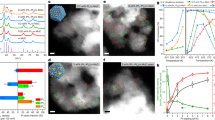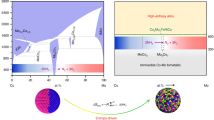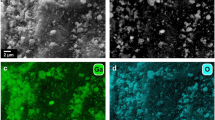Abstract
The recent availability of shale gas has led to a renewed interest in C–H bond activation as the first step towards the synthesis of fuels and fine chemicals. Heterogeneous catalysts based on Ni and Pt can perform this chemistry, but deactivate easily due to coke formation. Cu-based catalysts are not practical due to high C–H activation barriers, but their weaker binding to adsorbates offers resilience to coking. Using Pt/Cu single-atom alloys (SAAs), we examine C–H activation in a number of systems including methyl groups, methane and butane using a combination of simulations, surface science and catalysis studies. We find that Pt/Cu SAAs activate C–H bonds more efficiently than Cu, are stable for days under realistic operating conditions, and avoid the problem of coking typically encountered with Pt. Pt/Cu SAAs therefore offer a new approach to coke-resistant C–H activation chemistry, with the added economic benefit that the precious metal is diluted at the atomic limit.
This is a preview of subscription content, access via your institution
Access options
Access Nature and 54 other Nature Portfolio journals
Get Nature+, our best-value online-access subscription
$29.99 / 30 days
cancel any time
Subscribe to this journal
Receive 12 print issues and online access
$259.00 per year
only $21.58 per issue
Buy this article
- Purchase on Springer Link
- Instant access to full article PDF
Prices may be subject to local taxes which are calculated during checkout





Similar content being viewed by others
References
Sattler, J. J. H. B., Ruiz-Martinez, J., Santillan-Jimenez, E. & Weckhuysen, B. M. Catalytic dehydrogenation of light alkanes on metals and metal oxides. Chem. Rev. 114, 10613–10653 (2014).
Alper, J. The Changing Landscape of Hydrocarbon Feedstocks for Chemical Production: Implications for Catalysis: Proceedings of a Workshop (The National Academies Press, 2016).
Shilov, A. E. & Shul'pin, G. B. Activation of C–H bonds by metal complexes. Chem. Rev. 97, 2879–2932 (1997).
Labinger, J. A. & Bercaw, J. E. Understanding and exploiting C–H bond activation. Nature 417, 507–514 (2002).
Wencel-Delord, J. & Glorius, F. C–H bond activation enables the rapid construction and late-stage diversification of functional molecules. Nat. Chem. 5, 369–375 (2013).
Zhao, Z.-J., Chiu, C. & Gong, J. Molecular understandings on the activation of light hydrocarbons over heterogeneous catalysts. Chem. Sci. 6, 4403–4425 (2015).
Lin, R., Amrute, A. P. & Pérez-Ramírez, J. Halogen-mediated conversion of hydrocarbons to commodities. Chem. Rev. 117, 4182–4247 (2017).
McFarland, E. Unconventional chemistry for unconventional natural gas. Science 338, 340–342 (2012).
Gärtner, C. A., van Veen, A. C. & Lercher, J. A. Oxidative dehydrogenation of ethane: common principles and mechanistic aspects. ChemCatChem 5, 3196–3217 (2013).
Schwarz, H. Chemistry with methane: concepts rather than recipes. Angew. Chem. Int. Ed. 50, 10096–10115 (2011).
Guo, X. et al. Direct, nonoxidative conversion of methane to ethylene, aromatics, and hydrogen. Science 344, 616–619 (2014).
Schweitzer, N. M. et al. Propylene hydrogenation and propane dehydrogenation by a single-site Zn2+ on silica catalyst. ACS Catal. 4, 1091–1098 (2014).
Swaan, H. M., Kroll, V. C. H., Martin, G. A. & Mirodatos, C. Deactivation of supported nickel catalysts during the reforming of methane by carbon dioxide. Catal. Today 21, 571–578 (1994).
Ruckenstein, E. & Hu, Y. H. Carbon dioxide reforming of methane over nickel/alkaline earth metal oxide catalysts. Appl. Catal. A 133, 149–161 (1995).
Taccardi, N. et al. Gallium-rich Pd–Ga phases as supported liquid metal catalysts. Nat. Chem. 9, 862–867 (2017).
Jiang, F. et al. Propane dehydrogenation over Pt/TiO2–Al2O3 catalyst. ACS Catal. 5, 438–447 (2015).
Iglesias-Juez, A. et al. A combined in situ time-resolved UV-vis, Raman and high-energy resolution X-ray absorption spectroscopy study on the deactivation behavior of Pt and PtSn propane dehydrogenation catalysts under industrial reaction conditions. J. Catal. 276, 268–279 (2010).
Henderson, M. A., Mitchell, G. E. & White, J. M. The chemisorption of methyl halides (Cl, Br, and I) on Pt(111). Surf. Sci. 184, L325–L331 (1987).
Yang, F., Koeller, J. & Ackermann, L. Photoinduced copper-catalyzed C–H arylation at room temperature. Angew. Chem. Int. Ed. 55, 4759–4762 (2016).
Besenbacher, F. et al. Design of a surface alloy catalyst for steam reforming. Science 279, 1913–1915 (1998).
Rodriguez, J. A. Physical and chemical properties of bimetallic surfaces. Surf. Sci. Rep. 24, 223–287 (1996).
Lucci, F. R., Marcinkowski, M. D., Lawton, T. J. & Sykes, E. C. H. H2 activation and spillover on catalytically relevant Pt–Cu single atom alloys. J. Phys. Chem. C 119, 24351–24357 (2015).
Lucci, F. R. et al. Selective hydrogenation of 1,3-butadiene on platinum–copper alloys at the single-atom limit. Nat. Commun. 6, 8550 (2015).
Lucci, F. R., Lawton, T. J., Pronschinske, A. & Sykes, E. C. H. Atomic scale surface structure of Pt/Cu(111) surface alloys. J. Phys. Chem C. 118, 3015–3022 (2014).
Yang, X. F. et al. Single-atom catalysts: a new frontier in heterogeneous catalysis. Acc. Chem. Res. 46, 1740–1748 (2013).
Thomas, J. M., Saghi, Z. & Gai, P. L. Can a single atom serve as the active site in some heterogeneous catalysts? Top. Catal. 54, 588–594 (2011).
Azizian, S. & Gobal, F. Mechanism of catalytic decomposition of CH3I on the Cu(111) surface: a UBI-QEP approach. Langmuir 16, 8095–8099 (2000).
Chiang, C. -M., Wentzlaff, T. H. & Bent, B. E. Iodomethane decomposition on copper(110): surface reactions of C1 fragments. J. Phys. Chem. 96, 1836–1848 (1992).
French, C. & Harrison, I. Orientation and decomposition kinetics of methyl iodide on Pt(111). Surf. Sci. 342, 85–100 (1995).
Lin, J.-L. & Bent, B. E. Iodomethane dissociation on Cu(111): bonding and chemistry of adsorbed methyl groups. J. Vac. Sci. Technol. A 10, 2202–2209 (1992).
Lin, J.-L. & Bent, B. E. Two mechanisms for formation of methyl radicals during the thermal decomposition of CH3I on a Cu(111) surface. J. Phys. Chem. 97, 9713–9718 (1993).
Zaera, F. Study of the surface chemistry of methyl iodide coadsorbed with hydrogen on Pt(111). Surf. Sci. 262, 335–350 (1992).
Pascal, M. et al. Methyl on Cu(111)–structural determination including influence of co-adsorbed iodine. Surf. Sci. 512, 173–184 (2002).
Chao-Ming, C. & Bent, B. E. Methyl radical adsorption on Cu(111): bonding, reactivity, and the effect of coadsorbed iodine. Surf. Sci. 279, 79–88 (1992).
Canning, N. D. S., Baker, M. D. & Chesters, M. A. Ethylene and acetylene adsorption on Cu(111) and Pt(111) studied by Auger spectroscopy. Surf. Sci. 111, 441–451 (1981).
Meyers, J. M. & Gellman, A. J. The investigation of fluorinated propenes on the Cu(111) surface. Surf. Sci. 339, 57–67 (1995).
Liu, J. et al. Tackling CO poisoning with single atom alloy catalysts. J. Am. Chem. Soc. 138, 6396–6399 (2016).
Henkelman, G. & Jónsson, H. A dimer method for finding saddle points on high dimensional potential surfaces using only first derivatives. J. Chem. Phys. 111, 7010–7022 (1999).
Henkelman, G. & Jónsson, H. Improved tangent estimate in the nudged elastic band method for finding minimum energy paths and saddle points. J. Chem. Phys. 113, 9978–9985 (2000).
Psofogiannakis, G., St-Amant, A. & Ternan, M. Methane oxidation mechanism on Pt(111): a cluster model DFT study. J. Phys. Chem. B 110, 24593–24605 (2006).
Chan, Y. L., Pai, W. W. & Chuang, T. J. Direct observation of methyl radicals islanding on copper surfaces and its effects on the kinetics of catalytic reactions. J. Phys. Chem. B 108, 815–818 (2004).
Michaelides, A. & Hu, P. Softened C–H modes of adsorbed methyl and their implications for dehydrogenation: an ab initio study. J. Chem. Phys. 114, 2523–2526 (2001).
Andryushechkin, B. V., Eltsov, K. N. & Shevlyuga, V. M. Atomic scale observation of iodine layer compression on Cu(111). Surf. Sci. 472, 80–88 (2001).
Deng, W. & Flytzani-Stephanopoulos, M. On the issue of the deactivation of Au–ceria and Pt–ceria water–gas shift catalysts in practical fuel-cell applications. Angew. Chem. 118, 2343–2347 (2006).
Kresse, G. & Furthmüller, J. Efficiency of ab-initio total energy calculations for metals and semiconductors using a plane-wave basis set. Comput. Mater. Sci. 6, 15–50 (1996).
Kresse, G. & Furthmüller, J. Efficient iterative schemes for ab initio total-energy calculations using a plane-wave basis set. Phys. Rev. B 54, 11169–11186 (1996).
Klimeš, J., Bowler, D. R. & Michaelides, A. Van der Waals density functionals applied to solids. Phys. Rev. B 83, 195131 (2011).
Dion, M., Rydberg, H., Schröder, E., Langreth, D. C. & Lundqvist, B. I. Van der Waals density functional for general geometries. Phys. Rev. Lett. 92, 246401 (2004).
Stamatakis, M. & Vlachos, D. G. A graph-theoretical kinetic Monte Carlo framework for on-lattice chemical kinetics. J. Chem. Phys. 134, 214115 (2011).
Nielsen, J., D'Avezac, M., Hetherington, J. & Stamatakis, M. Parallel kinetic Monte Carlo simulation framework incorporating accurate models of adsorbate lateral interactions. J. Chem. Phys. 139, 224706 (2013).
Marcinkowski, M. D. et al. Selective formic acid dehydrogenation on Pt-Cu single-atom alloys. ACS Catal. 7, 413–420 (2017).
Boucher, M. B. et al. Single atom alloy surface analogs in Pd0.18Cu15 nanoparticles for selective hydrogenation reactions. Phys. Chem. Chem. Phys. 15, 12187–12196 (2013).
Acknowledgements
All surface science studies (M.D.M., F.R.L. and E.C.H.S.) were performed with support from the Division of Chemical Sciences, Office of Basic Energy Sciences, CPIMS Program, US Department of Energy, under grant no. FG02-10ER16170. J.L. and M.F-S. acknowledge the US Department of Energy (DE-FG02-05ER15730) for financial support of the catalysis work. The X-ray absorption spectroscopy research used resources of the Advanced Photon Source, a US Department of Energy Office of Science, User Facility operated for the Department of Energy Office of Science by Argonne National Laboratory under contract no. DE-AC02-06CH11357. M.T.D is funded by the Engineering and Physical Sciences Research Council UK as part of a Doctoral Training Grant (Award Ref. 1352369). The authors acknowledge the use of the UCL High Performance Computing Facilities (Legion@UCL and Grace@UCL) and associated support services, in the completion of the computational part of this work. The theoretical portion of the research also used resources of the Oak Ridge Leadership Computing Facility, which is a DOE Office of Science User Facility supported under contract no. DE-AC05-00OR22725. Access to the Oak Ridge facility was provided via the Integrated Mesoscale Architectures for Sustainable Catalysis (IMASC), an Energy Frontier Research Center funded by the US Department of Energy, Office of Science, Basic Energy Sciences under award #DE-SC0012573. The development of software Zacros has been funded under the embedded Computer Science and Engineering (eCSE) programme of the ARCHER UK National Supercomputing Service (eCSE01-001, eCSE10-8). A.M. is supported by the European Research Council under the European Union's Seventh Framework Programme (FP/2007-2013)–European Research Council grant agreement no. 616121 (HeteroIce project). A.M. is also supported by the Royal Society through a Royal Society Wolfson Research Merit Award.
Author information
Authors and Affiliations
Contributions
M.D.M. performed the TPR experiments. M.T.D. performed the DFT and KMC calculations. M.D.M. and F.R.L. performed the STM experiments. J.L. and J.M.W. performed the nanoparticle experiments. S.L. performed the EXAFS measurements. M.D.M., M.T.D. and J.L. analysed the data from their relevant experimental/theoretical contributions. M.D.M., M.T.D., J.L., A.M., M.F.-S., M.S. and E.C.H.S. wrote the manuscript. All authors read and commented on the manuscript.
Corresponding authors
Ethics declarations
Competing interests
The authors declare no competing financial interests.
Supplementary information
Supplementary information
Supplementary information (PDF 3207 kb)
Rights and permissions
About this article
Cite this article
Marcinkowski, M., Darby, M., Liu, J. et al. Pt/Cu single-atom alloys as coke-resistant catalysts for efficient C–H activation. Nature Chem 10, 325–332 (2018). https://doi.org/10.1038/nchem.2915
Received:
Accepted:
Published:
Issue Date:
DOI: https://doi.org/10.1038/nchem.2915
This article is cited by
-
Site-selective protonation enables efficient carbon monoxide electroreduction to acetate
Nature Communications (2024)
-
Single-atom alloys prepared by two-step thermal evaporation
Nano Research (2024)
-
Tailoring the d-band center on Ru1Cu single-atom alloy nanotubes for boosting electrochemical non-enzymatic glucose sensing
Analytical and Bioanalytical Chemistry (2024)
-
Fundamentals and catalytic applications of single-atom alloys
Science China Materials (2024)
-
Charge-asymmetry Fe1Cu single-atom alloy catalyst for efficient oxygen reduction reaction
Nano Research (2024)



